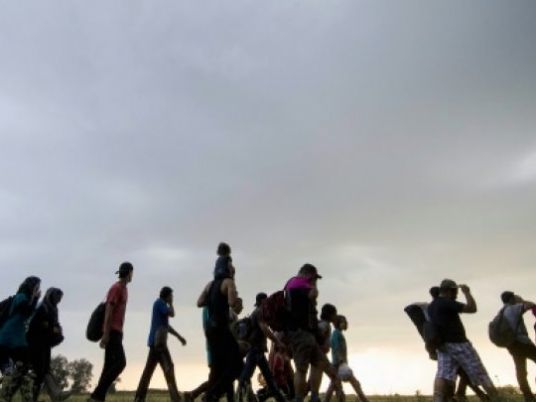
The 100 or so refugees set off early evening, hoping that the short walk across Serbia's border into Hungary will be the last leg of their treacherous journey into the EU.
The group are mostly Syrians. Young and old, fathers carrying children on shoulders, mothers with toddlers. One man has a head wound, mugged he says by "Serbian mafia" the previous day.
"We walk together for protection, the journey is scary, especially for the women and children," says Mohamed, 25, a doctor who fled Homs.
"We go by night, to avoid the police, we want to make it to Germany or Sweden," he says.
Non-EU Serbia's frontier with Hungary, which is in the bloc's passport-free Schengen zone, has become a major crossing point for the huge numbers of migrants entering the EU.
So far this year, Hungary has registered more than 100,000 asylum-seekers, over double the total for all of 2014 and compared with just 2,000 in 2012.
Almost all — currently 1,500 a day, up from 1,000 a few months ago — cross from Serbia, and Hungary's right-wing government of Prime Minister Viktor Orban has had enough.
To stem the flow, a four-meter (13-foot) high barbed wire fence all along the 175-kilometer (110-mile) border is being erected. The first part was to be finished on Sunday, and the whole thing by August 31.
Currently, most of the migrants are spotted by heat cameras on pylons lining the frontier, now scanned by German and Austrian police sent by EU border agency Frontex, as well as the Hungarians.
Some simply hand themselves over as soon as they cross, needing urgent shelter.
After turning onto a dirt track alongside a river as dusk falls, the group accompanied by AFP all scatter when they see the flashing blue lights of a Hungarian police car.
"Why don't they just let us through, we don't want to get stuck in Hungary," says Mohamed.
Bottleneck
In the Serbian border town of Kanjiza visited by AFP, migrants gather on the shady main square to rest and prepare for the walk.
"They don't get much help from local people, so I do what I can, bring water, give directions," says resident Katalin Varga.
Their presence has caused tensions, however, and hoteliers complain of a drop in tourist bookings.
"They (the tourists) come for the spas and the peace and quiet, but not this year," says the owner of a hotel on the square.
Many locals worry that their town will become a bottleneck after Hungary finishes its fence and starts deporting people back to Serbia as it has threatened.
When a torrential storm breaks out, police force another hotelier to give shelter to dozens of drenched refugees including many small children.
Early the next morning, the outraged owner orders them to leave: "You cannot stay longer, get out now," he shouts.
"We had to pay five euros ($5.45) each to stay inside — no bed, no food or water, not even for the children," says Salem, a 22-year-old student nurse from Aleppo.
"Where is the Christianity?" he asks, packing his rucksack with still damp clothes, and the sodden official document allowing him temporary transit in Serbia.
'Europe for Europeans'
Those intercepted in Hungary, which has a population of 10 million, are brought to a registration center in the city of Szeged. Almost all claim asylum and are then sent to refugee camps around the central European country.
But the large majority move on from Hungary when they can, with only 5,000 to 10,000 asylum seekers in the country at any one time, according to estimates from the Hungarian Helsinki Committee, a refugee rights group.
The newcomers are not guaranteed a warm welcome, with Orban's government branding them potential terrorists and putting up billboards with slogans such as "We don't want illegal immigrants!"
"Europe should remain for Europeans," Orban said in a speech last month.
But many Hungarians do what they can.
At Szeged train station, teams of volunteers, organized on social media, distribute donated food, water and medicine to the often bewildered migrants, and help them take the right train to the camps.
"The fence is just a message to Hungarian voters, it won't stop people who have crossed continents on foot," says Mark Kekesi, one of the volunteers.




